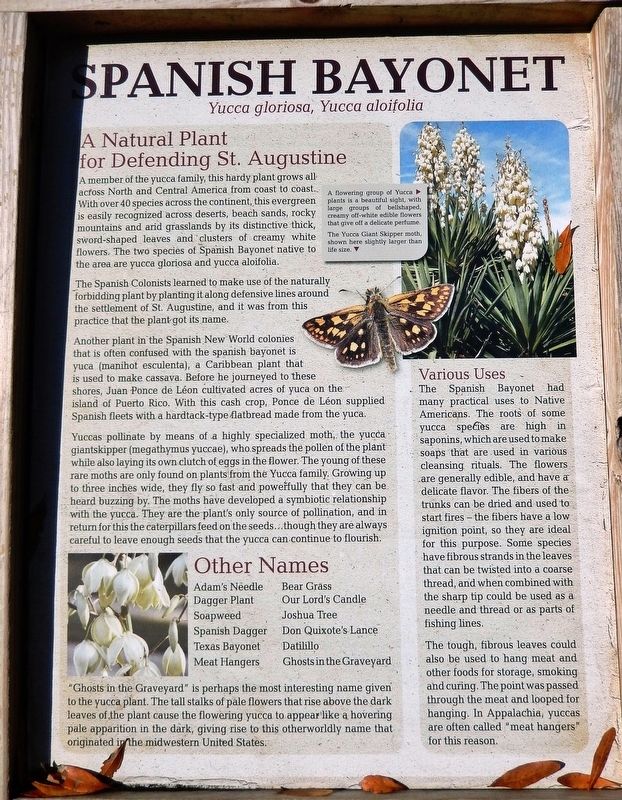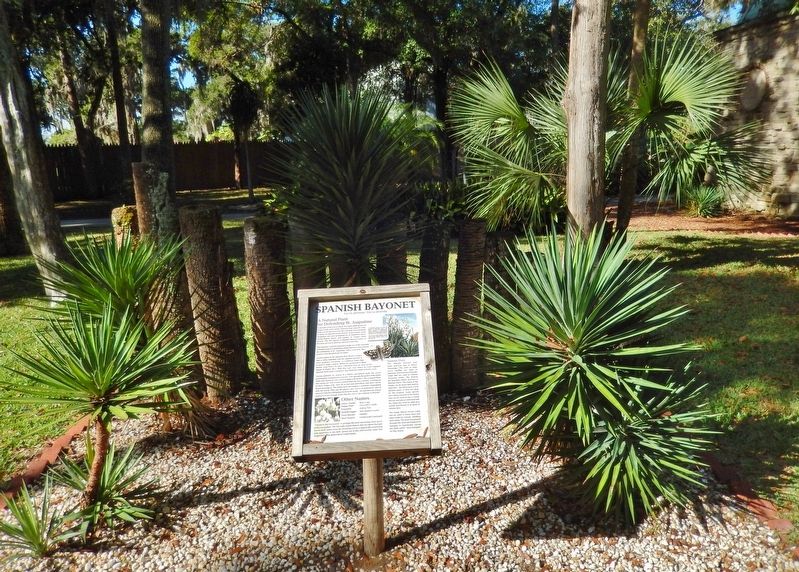St. Augustine in St. Johns County, Florida — The American South (South Atlantic)
Spanish Bayonet
Yucca gloriosa, Yucca aloifolia
A Natural Plant for Defending St. Augustine
A member of the yucca family, this hardy plant grows all across North and Central America from coast to coast. With over 40 species across the continent, this evergreen is easily recognized across deserts, beach sands, rocky mountains and arid grasslands by its distinctive thick, sword-shaped leaves and clusters of creamy white flowers. The two species of Spanish Bayonet native to the area are yucca gloriosa and yucca aloifolia.
The Spanish Colonists learned to make use of the naturally forbidding plant by planting it along defensive lines around the settlement of St. Augustine, and it was from this practice that the plant got its name.
Another plant in the Spanish New World colonies that is often confused with the Spanish bayonet is yuca (manihot esculenta), a Caribbean plant that is used to make cassava. Before he journeyed to these shores, Juan Ponce de León cultivated acres of yuca on the island of Puerto Rico. With this cash crop, Ponce de León supplied Spanish fleets with a hardtack-type flatbread made from the yuca.
Yuccas pollinate by means of a highly specialized moth, the yucca giantskipper (megathymus yuccae), who spreads the pollen of the plant while also laying its own clutch of eggs in the flower. The young of these rare moths are only found on plants from the Yucca family. Growing up to three inches wide, they fly so fast and powerfully that they can be heard buzzing by. The moths have developed a symbiotic relationship with the yucca. They are the plant's only source of pollination, and in return for this the caterpillars feed on the seeds… though they are always careful to leave enough seeds that the yucca can continue to flourish.
Other Names
Adam's Needle • Bear Grass • Dagger Plant • Our Lord's Candle • Soapweed • Joshua Tree • Spanish Dagger • Don Quixote's Lance • Texas Bayonet • Datilillo • Meat Hangers • Ghosts in the Graveyard
"Ghosts in the Graveyard" is perhaps the most interesting name given to the yucca plant. The tall stalks of pale flowers that rise above the dark leaves of the plant cause the flowering yucca to appear like a hovering pale apparition in the dark, giving rise to this otherworldly name that originated in the midwestern United States.
Various Uses
The Spanish Bayonet had many practical uses to Native Americans. The roots of some yucca species are high in saponins, which are used to make soaps that are used in various cleansing rituals. The flowers are generally edible, and have a delicate flavor. The fibers of the trunks can be dried and used to start fires — the fibers have a low ignition point, so they are ideal for this purpose. Some species have fibrous strands in the leaves that can be twisted into a coarse thread, and when combined with the sharp tip could be used as a needle and thread or as parts of fishing lines.
The tough, fibrous leaves could also be used to hang meat and other foods for storage, smoking and curing. The point was passed through the meat and looped for hanging. In Appalachia, yuccas are often called "meat hangers" for this reason.
[photo captions]
• A flowering group of Yucca plants is a beautiful sight, with large groups of bellshaped, creamy off-white edible flowers that give off a delicate perfume.
• The Yucca Giant Skipper moth, shown here slightly larger than life size.
Topics. This historical marker is listed in these topic lists: Agriculture • Colonial Era • Native Americans • Settlements & Settlers.
Location. 29° 54.397′ N, 81° 18.941′ W. Marker is in St. Augustine, Florida, in St. Johns County. Marker can be reached from Williams Street east of Magnolia Avenue. Marker is located along the interpretive trail in Ponce de León's Fountain of Youth Archaeological Park. Touch for map. Marker is at or near this postal address: 11 Magnolia Avenue, Saint Augustine FL 32084, United States of America. Touch for directions.
Other nearby markers. At least 8 other markers are within walking distance of this marker . Spanish Cannon (here, next to this marker); Ancient Civilization Uncovered! (a few steps from this marker); 1565 Menendez (a few steps from this marker); 1513 La Florida (a few steps from this marker); Tabby / Coquina (a few steps from this marker); Juan Ponce (a few steps from this marker); Coontie (a few steps from this marker); 4,000 BC (a few steps from this marker). Touch for a list and map of all markers in St. Augustine.
Related markers. Click here for a list of markers that are related to this marker. Ponce de León's Fountain of Youth Archaeological Park
Also see . . . Yucca. Wikipedia entry (Submitted on July 7, 2023, by Larry Gertner of New York, New York.)
Credits. This page was last revised on July 7, 2023. It was originally submitted on December 28, 2021, by Cosmos Mariner of Cape Canaveral, Florida. This page has been viewed 468 times since then and 59 times this year. Photos: 1, 2. submitted on December 29, 2021, by Cosmos Mariner of Cape Canaveral, Florida.

